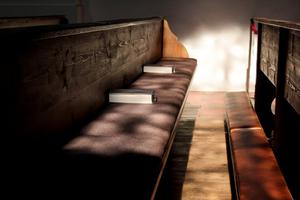Analysis Shows Number of Nonreligious Americans Stabilizing After Prior Surge
Several factors contribute to the initial surge, along with the subsequent stabilization in the percentage of Americans who don’t identify with a particular religion, according to Burge.

From the early 1990s through the 2010s, the number of Americans who identified as atheist, agnostic, and nonaffiliated saw a major surge — but that number appears to be stabilizing, according to an analysis published on May 20.
Ryan Burge, a political scientist at Eastern Illinois University and a Baptist pastor, published an analysis of religious demographic data from the annual Cooperative Election Study, comparing 2023 numbers with previous years. He found that in the past five years — from 2019 through 2023 — the number of Americans who do not identify with a particular religion has been relatively stable.
In 2019, the analysis notes, the percentage of Americans who identified as nonreligious was at 35%. By 2023, the percentage only increased by one percentage point — to 36%. Over those five years, the percentage of nonreligious Americans fluctuated between 34% and 36% — without any major surge or reduction.
“It’s slowed down considerably,” Burge told CNA.
The stabilization shows a halt — or at least a pause — in previous trends, which showed a rise in Americans identifying themselves as atheist, agnostic, or no particular religion. The first major surge occurred in the 1990s, which continued into the 2010s.
The growth in this demographic slowed down between 2013 and 2018, increasing by only two percentage points in that time frame, from 30% to 32%. In 2019, it saw another surge to 35% but has remained relatively stable since then, only increasing by one more percentage point by 2023.
“We can definitely say there’s been a pause [in the growth of nonreligious Americans],” Joe Heschmeyer, a staff apologist at Catholic Answers, told CNA. “We can much less reliably predict what the future holds.”
Several factors contribute to the initial surge, along with the subsequent stabilization in the percentage of Americans who don’t identify with a particular religion, according to Burge.
Burge noted the fall of the Soviet Union and the Berlin Wall as two factors contributing to this surge in the United States, because there was “less stigma [around atheism and a lack of religiosity] when we weren’t in the Cold War anymore.” The rise of the internet in the 1990s, he also mentioned, made it easier for skeptics of religion to associate with like-minded people, even if they lived in relatively religious communities.
In this time frame, Burge said “the marginal Christian” began to stop identifying with a particular religion. The current numbers, he said, demonstrate what the United States “really looks like religiously.”
Heschmeyer said there used to be a “default Christianity” in which people who did not strongly believe in the faith still identified with it. But that identity “is basically gone now” and as society has secularized, “they’ve kind of drifted along with that,” he added.
Heschmeyer noted a few factors that led to the surge in Americans no longer identifying with a particular religion. After the Sept. 11, 2001, terrorist attacks, he said there was an “anxiety” with “people worried about militant Islam.” He noted the rise in new atheism, which claimed the “problem is religion itself” but said as this fear has dissipated, “atheists can’t tap into that the same way.”
Another element noted in Burge’s analysis is the religiosity of various age groups. Although older Americans are more likely to identify with a particular religion than younger Americans, the analysis points out that Generation Z’s religiosity — at this moment — is nearly identical to the religiosity of millennials. This suggests that the growth of nonreligious Americans appears to be stabilizing at a generational level as well.
“This drastic generational change ended with millennials,” Burge said.
Looking to the future, Burge said the lack of religiosity will probably grow slightly, “largely due to … replacement” as older Americans die. However, he said he expects “less deconversion over the next 10 years.”
Heschmeyer said there is “a real spiritual battle that is ongoing.” While he said the future religious makeup of the country is hard to predict, he noted that there have always been predictions that organized religion would fade away but that “none of those dire predictions came true.”
“The Church is not going anywhere,” Heschmeyer said.
- Keywords:
- nones















